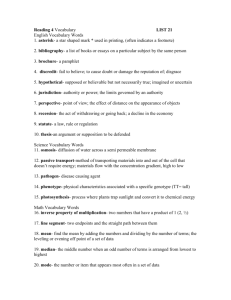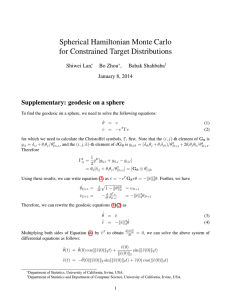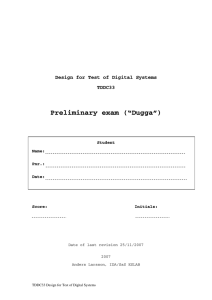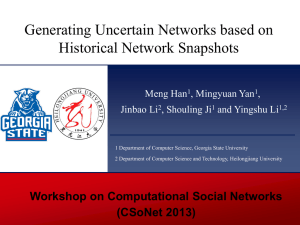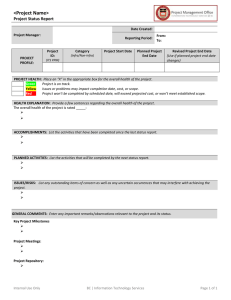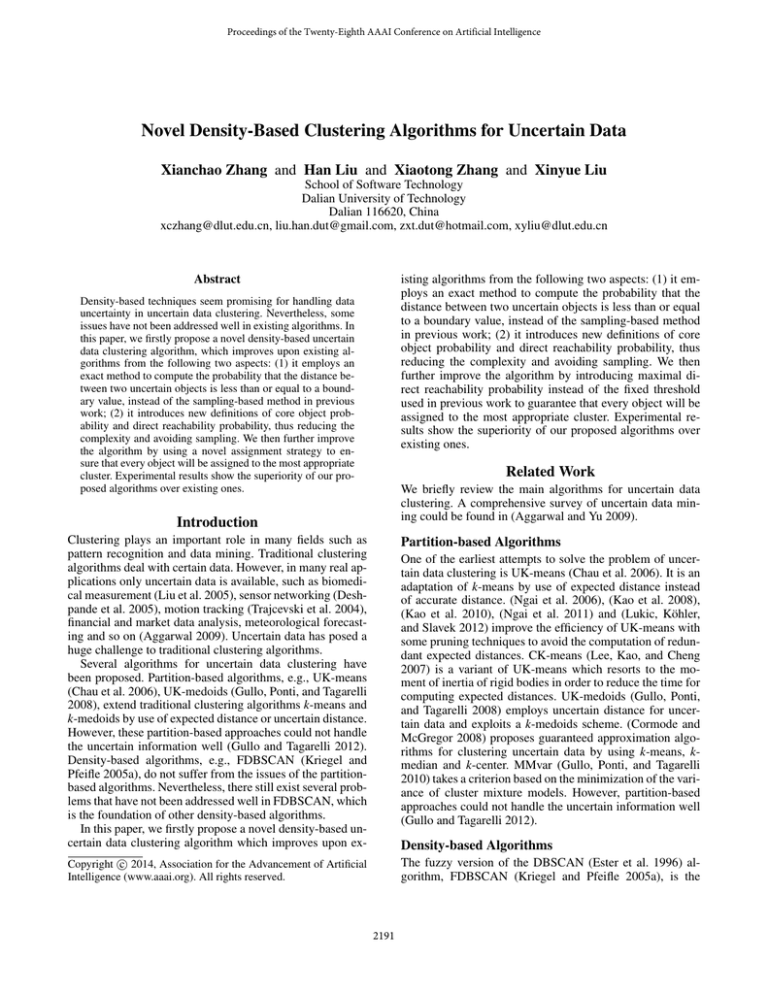
Proceedings of the Twenty-Eighth AAAI Conference on Artificial Intelligence
Novel Density-Based Clustering Algorithms for Uncertain Data
Xianchao Zhang and Han Liu and Xiaotong Zhang and Xinyue Liu
School of Software Technology
Dalian University of Technology
Dalian 116620, China
xczhang@dlut.edu.cn, liu.han.dut@gmail.com, zxt.dut@hotmail.com, xyliu@dlut.edu.cn
Abstract
isting algorithms from the following two aspects: (1) it employs an exact method to compute the probability that the
distance between two uncertain objects is less than or equal
to a boundary value, instead of the sampling-based method
in previous work; (2) it introduces new definitions of core
object probability and direct reachability probability, thus
reducing the complexity and avoiding sampling. We then
further improve the algorithm by introducing maximal direct reachability probability instead of the fixed threshold
used in previous work to guarantee that every object will be
assigned to the most appropriate cluster. Experimental results show the superiority of our proposed algorithms over
existing ones.
Density-based techniques seem promising for handling data
uncertainty in uncertain data clustering. Nevertheless, some
issues have not been addressed well in existing algorithms. In
this paper, we firstly propose a novel density-based uncertain
data clustering algorithm, which improves upon existing algorithms from the following two aspects: (1) it employs an
exact method to compute the probability that the distance between two uncertain objects is less than or equal to a boundary value, instead of the sampling-based method in previous
work; (2) it introduces new definitions of core object probability and direct reachability probability, thus reducing the
complexity and avoiding sampling. We then further improve
the algorithm by using a novel assignment strategy to ensure that every object will be assigned to the most appropriate
cluster. Experimental results show the superiority of our proposed algorithms over existing ones.
Related Work
We briefly review the main algorithms for uncertain data
clustering. A comprehensive survey of uncertain data mining could be found in (Aggarwal and Yu 2009).
Introduction
Clustering plays an important role in many fields such as
pattern recognition and data mining. Traditional clustering
algorithms deal with certain data. However, in many real applications only uncertain data is available, such as biomedical measurement (Liu et al. 2005), sensor networking (Deshpande et al. 2005), motion tracking (Trajcevski et al. 2004),
financial and market data analysis, meteorological forecasting and so on (Aggarwal 2009). Uncertain data has posed a
huge challenge to traditional clustering algorithms.
Several algorithms for uncertain data clustering have
been proposed. Partition-based algorithms, e.g., UK-means
(Chau et al. 2006), UK-medoids (Gullo, Ponti, and Tagarelli
2008), extend traditional clustering algorithms k-means and
k-medoids by use of expected distance or uncertain distance.
However, these partition-based approaches could not handle
the uncertain information well (Gullo and Tagarelli 2012).
Density-based algorithms, e.g., FDBSCAN (Kriegel and
Pfeifle 2005a), do not suffer from the issues of the partitionbased algorithms. Nevertheless, there still exist several problems that have not been addressed well in FDBSCAN, which
is the foundation of other density-based algorithms.
In this paper, we firstly propose a novel density-based uncertain data clustering algorithm which improves upon ex-
Partition-based Algorithms
c 2014, Association for the Advancement of Artificial
Copyright Intelligence (www.aaai.org). All rights reserved.
The fuzzy version of the DBSCAN (Ester et al. 1996) algorithm, FDBSCAN (Kriegel and Pfeifle 2005a), is the
One of the earliest attempts to solve the problem of uncertain data clustering is UK-means (Chau et al. 2006). It is an
adaptation of k-means by use of expected distance instead
of accurate distance. (Ngai et al. 2006), (Kao et al. 2008),
(Kao et al. 2010), (Ngai et al. 2011) and (Lukic, Köhler,
and Slavek 2012) improve the efficiency of UK-means with
some pruning techniques to avoid the computation of redundant expected distances. CK-means (Lee, Kao, and Cheng
2007) is a variant of UK-means which resorts to the moment of inertia of rigid bodies in order to reduce the time for
computing expected distances. UK-medoids (Gullo, Ponti,
and Tagarelli 2008) employs uncertain distance for uncertain data and exploits a k-medoids scheme. (Cormode and
McGregor 2008) proposes guaranteed approximation algorithms for clustering uncertain data by using k-means, kmedian and k-center. MMvar (Gullo, Ponti, and Tagarelli
2010) takes a criterion based on the minimization of the variance of cluster mixture models. However, partition-based
approaches could not handle the uncertain information well
(Gullo and Tagarelli 2012).
Density-based Algorithms
2191
foundation of other density-based algorithms for uncertain
data clustering. FOPTICS (Kriegel and Pfeifle 2005b) is
extended from the hierarchical density-based clustering algorithm OPTICS (Ankerst et al. 1999) to deal with uncertain data. (Günnemann, Kremer, and Seidl 2010) extends the
density-based algorithm to subspace clustering for high dimensional uncertain data. Density-based algorithms do not
suffer from the issues of the partition-based algorithms, thus
they seem more promising for uncertain data. Nevertheless,
as we point out in the following section, there still exist several problems that have not been addressed well.
Figure 1: Issues of FDBSCAN
of a core object. From this definition, we can get that the core
core
object probability PEps,M
inP ts,d,D (o) is equal to the probability value P (|NEps (o)| > M inP ts), which indicates the
likelihood that o is a core object (Kriegel and Pfeifle 2005a).
|NEps (o)| denotes the number of the objects in the Epscore
range of o. If PEps,M
inP ts,d,D (o) > 0.5, object o can be
regarded as a core object.
FDBSCAN Issues
In this section, we review the FDBSCAN algorithm and
point out several issues that have not been addressed well.
FDBSCAN Basics
In general, data uncertainty can be considered at table, tuple
or attribute level, and is usually specified by fuzzy models,
evidence-oriented models, or probabilistic models (Sarma et
al. 2009). Here we focus on the attribute-level uncertainty
in a probabilistic model. In particular, an uncertain object is
represented by a probability density function (pdf), which
describes the probability that the object appears at any position in a multidimensional space.
Definition 4 Reachability Probability: Let D be a database,
and let Pd : D × D → (IR0+ → [0...1]) be a distance
distribution function. p and o are two objects in D. Then,
the reachability probability of p w.r.t. o is defined as follows:
reach
core
PEps,M
inP ts,d,D (p, o) = PEps,M inP ts−1,d,D\{p} (o)
·Pd (p, o)(Eps)
0
Definition 1 Distance Density Function: o and o are two
objects in database D. Let d : D × D → IR0+ be a distance
function, and let P (a 6 d(o, o0 ) 6 b) denote the probability
that d(o, o0 ) is between a and b. Then a probability density
function pd : D × D → (IR0+ → IR0+ ∪ ∞) is called a
distance density function if the following condition holds:
Z b
0
P (a 6 d(o, o ) 6 b) =
pd (o, o0 )dx
(1)
reach
If PEps,M
inP ts,d,D (p, o) > 0.5, object p can be regarded as
directly density-reachable to object o.
Based on the above definitions, FDBSCAN extends the
traditional DBSCAN algorithm for handling uncertain data.
Unaddressed Issues
The following issues are not addressed well in FDBSCAN.
Losing uncertain information: FDBSCAN does not provide an exact function for calculating pd (o, o0 ). Instead, it
uses the sampling method to calculate the probability that
the distance between two uncertain objects is less than or
equal to a boundary value. However, sampling may lose
some uncertain information, even cause wrong results. Take
an example in Figure 1. a and o are two uncertain objects,
the rectangles are their uncertain regions, Eps is a distance
threshold. We need to calculate the probability that the distance between a and o is less than or equal to Eps. The sampling rate is 3. If the sampling objects of a are a1 , a2 , a3 and
the sampling objects of o are o1 , o2 , o3 , then the probability
we want to calculate equals 0. But the real distance between
a and o is probably less than or equal to Eps, i.e., the probability should not be 0.
High time complexity: When computing the core object
probability, FDBSCAN needs to determine for each subset A of D having a cardinality higher than M inP ts, the
probability that only the objects of A are within an Epsrange of o but no objects of D\A (Kriegel and Pfeifle
2005a). So the number of the subsets we need to consider is
|D|
M inP ts+1
M inP ts
0
1
C|D|
+ C|D|
+ ... + C|D| = 2|D| − C|D|
− C|D|
−
a
Definition 2 Distance Distribution Function: o and o0 are
two objects in database D. Let d : D × D → IR0+ be a
distance function, and let P (d(o, o0 ) 6 b) denote the probability that d(o, o0 ) is smaller than b. Then a probability
distribution function Pd : D × D → (IR0+ → [0...1]) is
called a distance distribution function if the following condition holds:
Pd (o, o0 )(b) = P (d(o, o0 ) 6 b)
Rb
From definition 1, Pd (o, o0 )(b) = −∞ pd (o, o0 )dx.
(2)
Definition 3 Core Object Probability: Let D be a database,
and let Pd : D × D → (IR0+ → [0...1]) be a distance
distribution function. Then, the core object probability of an
object o is defined as:
X
core
PEps,M
inP ts,d,D (o) =
A⊆D
|A| > M inP ts
(3)
Y
Y
Pd (p, o)(Eps)
(1 − Pd (p0 , o)(Eps))
p∈A
(4)
p0 ∈D\A
M inP ts−1
...−C|D|
, where C is the combinatorial symbol in the
binomial formula, M inP ts denotes the minimum number
where Eps denotes a distance threshold, M inP ts denotes
the minimum number of objects contained in the Eps-range
2192
of objects contained in the Eps-range of a core object and
|D| denotes the object number of the whole database. Thus
we nearly need to find every subset of the whole database if
M inP ts is very small. Take an example in Figure 1. a, b, c,
d and o are five uncertain objects, the rectangles are their uncertain regions. a, b, c and d are perhaps in the Eps-range of
o, M inP ts is 2, if we want to get the core object probability
of o, we have to consider 25 − C50 − C51 = 26 cases. Assume
that there are 500 uncertain objects in the Eps-range of o
and M inP ts is very small, then the number of the subsets
we need to consider will be as large as 2500 , so the computation is too time consuming.
Nonadaptive threshold: FDBSCAN applies a fixed threshold (f value) to judge whether an object is a core object and
whether an object is directly density-reachable. The fixed
threshold may cause error. For example, there are two objects p, q and only one cluster T , we set f value = 0.5, the
direct reachability probability between p and any core object in T is 0.51, the direct reachability probability between
q and any core object in T is 0.49. Because f value = 0.5, p
could be assigned to T , q could not be assigned to T , though
the direct reachability probability gap between p and q is
very small. Obviously it is not reasonable.
Figure 2: Computation of Equation 5
on x axis in [0, 3] and ow moves on y axis in [0, 4]. We
need to compute the probability that the distance between
ov and ow is less than or equal to 3. The pdfs of ov and
ow are fv = 1/3 and fw = 1/4 respectively, the constraint condition is d(ov , ow ) 6 RR
3, so the probability can
be computed as Pd(ov ,ow )63 =
fv (x) · fw (y)dxdy =
R 3 R √9−x2
1/12 · 0 dx 0
dy = 9π
48 .
Definition 6 op is an uncertain object in database D, ∀oi ∈
D, then the probability Eps-neighborhood of op , denoted by
P N eighborhood(op ), is defined as:
P N eighborhood(op ) ← oi |Pd(oi ,op )6Eps > 0
(6)
The Proposed Algorithms
Definition 7 op is an uncertain object in database D, ∀oi ∈
D, then P NEps (op ) could be defined as:
X
P NEps (op ) =
Pd(oi ,op )6Eps (7)
In this section, we describe our new clustering algorithms
for uncertain data. Firstly we give some necessary definitions. Secondly we present the basic algorithm. Thirdly we
propose an improved version of the algorithm by introducing a new assignment strategy. Finally we analyze the time
complexity of the proposed algorithms.
oi ∈P N eighborhood(op )
Set a parameter M inP ts which denotes the minimum number of objects contained in the Eps-range of a core object, if
P NEps (op ) > M inP ts, op can be treated as a core object.
Definitions
Consider a set of uncertain objects D = {o1 , o2 , ..., on } in
m-dimensional independent space Rm with a distance function d : Rm × Rm → R defining the distance d(oi , oj ) > 0
between any objects oi , oj ∈ D. Each uncertain object
oi is associated with a probability density function (pdf)
fi : Rm → R, which gives the probability density of oi
in the uncertain region. The proposed algorithms are based
on the following definitions.
Definition 8 op is an uncertain object in database D,
∀oi ∈ D, then the core object probability of op , denoted
core
by PEps,M
inP ts,D (op ), is defined as:
core
PEps,M
inP ts,D (op ) = P NEps (op )/ |NEps (op )|
(8)
where |NEps (op )| is the number of the objects in
P N eighborhood(op ).
Definition 5 Given two uncertain objects oi , oj , whose associated pdfs are fi , fj respectively, x is the uncertain dimensionalities of oi , y is the uncertain dimensionalities of
oj , objects and dimensionalities are independent of each
other respectively, Eps is a distance threshold. Then the
probability of d(oi , oj ) 6 Eps, denoted by Pd(oi ,oj )6Eps ,
is defined as:
R
R
(
Pd(oi ,oj )6Eps =
fi (x) · fj (y)dxdy
x∈Rm y∈Rm
(5)
∀d(oi , oj ) 6 Eps
Definition 9 Given two uncertain objects op and oq
in database D, op is a core object, then the direct reachability probability of oq w.r.t. op , denoted by
dir−reach
PEps,M
inP ts,D (oq , op ), is defined as:
Here fi (x) · fj (y) can be regarded as the joint probability
density function. d(oi , oj ) 6 Eps is the additional limiting
condition for determining the integral interval.
Take an example in Figure 2, suppose there are two uncertain objects ov and ow , either of them is in a linear uncertain region with uniform distribution. The object ov moves
core
Explanation: PEps,M
inP ts−1,D\{oq } (op ) means the probability that at least M inP ts−1 objects from D\oq are located in the Eps-range of op ; Pd(oq ,op )6Eps means the probability that the distance between op and oq is less than
or equal to Eps. As these two events are independent of
each other, their product means the probability that at least
dir−reach
core
PEps,M
inP ts,D (oq , op ) = PEps,M inP ts−1,D\{oq } (op )
·Pd(oq ,op )6Eps
= (P NEps (op ) − Pd(oq .op )6Eps )/
(9)
(|NEps (op )| − 1) · Pd(oq ,op )6Eps
2193
Algorithm 1 PDBSCAN
M inP ts objects from D are located in the Eps-range of op
and oq is one of them.
Through these definitions, we can use the new methods to
compute core object probability and direct reachability probability, without finding most subsets of the whole dataset and
using any sampling method, thus reducing the complexity
and avoiding the loss of uncertain information.
Input: Uncertain dataset D = {o1 , o2 , ..., on }, Eps, M inP ts, f value
Output: A set of clusters, types of all objects in D
1: Compute the probability Pd(o ,o )6Eps , ∀oi , oj ∈ D by Equation 5
i
2:
3:
4:
5:
6:
7:
8:
9:
10:
11:
12:
13:
14:
PDBSCAN Algorithm
Our proposed algorithm is a probabilistic density-based uncertain data clustering algorithm, called PDBSCAN. It is
based on the principle that a cluster is a set of objects which
are directly density-reachable from an arbitrary core object
in the cluster.
Algorithm 1 and Algorithm 2 show the details of
PDBSCAN algorithm and the expand cluster procedure.
clu num = k means the current cluster number is k, k is
a positive integer. class(i) = 0, −1 or 1...k respectively
means that the object oi currently does not belong to any
cluster, has been determined to belong to noise or belong to
cluster 1, ..., cluster k. type(i) = 0, −1 or 1 respectively
means the object oi is a border object, a noise object or a
core object. visited(i) = 1 or 0 respectively means the object oi has been processed or not.
After a preliminary phase (Lines 1-2), PDBSCAN starts
from an unvisited object op , calculates the corresponding
P N eighborhood and P NEps (Lines 3-5). If P NEps equals
1, it indicates that the checked object is the only object in
its Eps-range, obviously it is a noise object (Lines 6-7). If
P NEps is between 1 and M inP ts, the information is not
enough to straightly judge the type of the checked object,
PDBSCAN does not need to do anything here, so this ifcondition is left out in the algorithm. If P NEps is greater
than or equal to M inP ts, it means that the checked object is
a core object, then PDBSCAN adds the objects whose direct
reachability probability from the checked object are greater
than or equal to the given threshold (f value) as the cluster
members (Lines 8-16), and calls the expand cluster procedure which further expands the cluster by adding the objects
whose direct reachability probability from the core objects
in the cluster members are greater than or equal to the given
threshold (f value) (Line 17). After the expansion procedure, if no objects can be added to the current cluster, the
algorithm finds another core object, adds cluster members
and expands the cluster. The procedure is repeated until no
objects can be added to any cluster, and the remaining objects are treated as outliers (Lines 21-23).
15:
16:
17:
18:
19:
20:
21:
22:
23:
j
Initialization: ∀oi ∈ D, class(i) = 0, type(i) = 0,
visited(i) = 0, clu num = 1
for each unvisited object op in dataset D do
Compute P N eighborhood(op ) by Equation 6
Compute P NEps (op ) by Equation 7
if P NEps (op ) = 1 then
class(p) ← −1,type(p) ← −1,visited(p) ← 1
else if P NEps (op ) > M inP ts then
class(p) ← clu num,type(p) ← 1,visited(p) ← 1
dir−reach
Compute PEps,M
(o , op ), ∀oi ∈ P N eighborhood(op )
inP ts,D i
for oi ∈ P N eighborhood(op ) do
dir−reach
if PEps,M inP ts,D (oi , op ) > f value then
class(i) ← clu num
P N eighborhood(op )0 ←
dir−reach
{oi |PEps,M
(o , op ) > f value}
inP ts,D i
end if
end for
Expand cluster(P N eighborhood(op )0 , clu num, f value, M inP ts)
clu num ← clu num + 1
end if
end for
for each oi which satisfies class(i) = 0 do
class(i) ← −1, type(i) ← −1,visited(i) ← 1
end for
Algorithm 2 Expand cluster(P N eighborhood(op )0 ,
clu num, f value, M inP ts)
1: for each object oq in P N eighborhood(op )0 do
2:
if oq is unvisited then
3:
visited(q) ← 1
4:
Compute P N eighborhood(oq ) by Equation 6
5:
Compute P NEps (oq ) by Equation 7
6:
if P NEps (oq ) > M inP ts then
7:
class(q) ← clu num, type(q) ← 1
dir−reach
8:
Compute PEps,M
(o , oq ), ∀oi ∈ P N eighborhood(oq )
inP ts,D i
9:
for oi ∈ P N eighborhood(oq ) do
dir−reach
10:
if PEps,M inP ts,D (oi , oq ) > f value then
11:
class(i) ← clu num
12:
P N eighborhood(oq )0 ←
dir−reach
{oi |PEps,M
(o , oq ) > f value}
inP ts,D i
13:
end if
14:
end for
15:
end if
16:
P N eighborhood(op )0 ←
P N eighborhood(op )0 ∪ P N eighborhood(oq )0
17:
else if oq is visited then
18:
Remove oq from P N eighborhood(op )0
19:
end if
20: end for
Algorithm 3 PDBSCANi
Input: Uncertain dataset D = {o1 , o2 , ..., on }, Eps, M inP ts
Output: A set of clusters, types of all objects in D
1-10: The same with lines 1-10 in PDBSCAN, the only change is that PDBSCANi adds
dir−reach−max
PEps,M
(oi ) and its initialization value is 0
inP ts,D
11:
for oi ∈ P N eighborhood(op ) do
dir−reach
dir−reach−max
12:
if PEps,M inP ts,D (oi , op ) > PEps,M
(oi ) then
inP ts,D
13:
class(i) ← clu num
14:
P N eighborhood(op )0 ← {oi |
dir−reach
dir−reach−max
PEps,M
(o , op ) > PEps,M
(oi )}
inP ts,D i
inP ts,D
Improved PDBSCAN Algorithm
PDBSCAN has addressed the first two issues in FDBSCAN.
We continue to solve the third issue by using the maximal direct reachability probability instead of the fixed direct reachability probability threshold. The definition of the maximal
direct reachability probability is as below.
dir−reach−max
dir−reach
PEps,M
(oi ) ← PEps,M
(o , op )
inP ts,D
inP ts,D i
end if
end for
Expand cluster max(P N eighborhood(op )0 ,
dir−reach−max
clu num, PEps,M
(oi ), M inP ts)
inP ts,D
19-24: The same with lines 18-23 in PDBSCAN
15:
16:
17:
18:
Definition 10 oi is an uncertain object in database D, for
an arbitrary core object op ∈ D, the maximal direct reachdir−reach−max
ability probability of oi , denoted by PEps,M
inP ts,D (oi ), is
defined as:
n
o
dir−reach−max
dir−reach
PEps,M
inP ts,D (oi ) ← max PEps,M inP ts,D (oi , op )
2194
Algorithm 4 Expand cluster max(P N eighborhood
dir−reach−max
(op )0 , clu num, PEps,M
inP ts,D (oi ), M inP ts)
1-9:
10:
11:
12:
Table 1: Datasets used in the experiment
Dataset
Iris
Wine
Glass
Ecoli
Yeast
Image
Abalone
The same with lines 1-9 in Expand cluster
dir−reach
dir−reach−max
if PEps,M
(o , oq ) > PEps,M
(oi ) then
inP ts,D i
inP ts,D
class(i) ← clu num
P N eighborhood(oq )0 ← {oi |
dir−reach
dir−reach−max
PEps,M
(o , oq ) > PEps,M
(oi )}
inP ts,D i
inP ts,D
dir−reach−max
dir−reach
13:
PEps,M
(oi ) ← PEps,M
(o , oq )
inP ts,D
inP ts,D i
14:
end if
15-21: The same with lines 14-20 in Expand cluster
Attributes
4
13
9
7
8
19
7
Classes
3
3
6
5
10
7
17
the results over 100 different runs. For FDBSCAN and FOPTICS, we follow the methods in (Kriegel and Pfeifle 2005a)
and (Kriegel and Pfeifle 2005b) respectively and choose a
sampling rate of s = 30. For FDBSCAN, FOPTICS, PDBSCAN and PDBSCANi, these algorithms are sensitive to parameters, so we adjust the parameters continuously until the
accuracy of each method becomes the best and stable, the
method of determining the parameters could refer to (Ester
et al. 1996) and (Ankerst et al. 1999).
dir−reach−max
If oi is a core object, then PEps,M
inP ts,D (oi ) = 1; If oi is
dir−reach−max
a noise object, then PEps,M inP ts,D (oi ) = 0.
Algorithm 3 and Algorithm 4 show the improved version
of PDBSCAN (PDBSCANi) and the new expand cluster
procedure. For PDBSCANi, the algorithm framework is
similar to PDBSCAN. Because of the limited space, the
same part has been left out in the algorithm description. The
important change is when finding cluster members, for each
object oi , with the update of the maximal direct reachability probability of oi , PDBSCANi keeps recording the corresponding core object op from which oi gets the maximal
direct reachability probability, further assigns oi to the corresponding cluster which op belongs to.
Through this way, we can address the nonadaptive threshold issue and guarantee that every object will be assigned
to the most appropriate cluster, thus further improving the
performance.
Accuracy
We use purity (Manning, Raghavan, and Schütze 2008),
which is one of the most commonly used criteria, to evaluate the accuracy of the clustering results. To compute purity,
each cluster is assigned to the class which is most frequent in
the cluster, and then the accuracy of this assignment is measured by counting the number of correctly assigned objects
and dividing by the whole number. Formally:
1 X
purity(Ω, C) =
max |wk ∩ cj |
(10)
j
N
k
Time Complexity
where Ω = {w1 , w2 , ..., wk } is the set of clusters and C =
{c1 , c2 , ..., ck } is the set of classes.
Table 2 shows the accuracy results. The last three rows of
this table report, for each algorithm, (i) the score for each
type of pdf averaged over all datasets (for short, Avg.); (ii)
the score averaged over all datasets and pdfs (for short, all
avg.score); (iii) the overall gain of PDBSCANi computed as
the difference between the overall average score of PDBSCANi and the overall average scores of the other algorithms (for short, all avg.gain).
From the overall average scores, it can be seen that the
score of PDBSCANi is always higher than those of the other
algorithms. PDBSCAN also performs better than the competitive algorithms in most cases, whereas PDBSCANi is
better than PDBSCAN with 0.0527 all avg.gain. Densitybased algorithms generally perform better than partitionbased algorithms on average, the reason is that the computation of expected distances or uncertain distances may cause
the loss of uncertain information. UK-medoids performs the
worst on average. PDBSCANi is the best with 0.7604 all
avg.score.
While the accuracy scores of the competitive algorithms
vary largely on different datasets, the accuracy score of
PDBSCANi is relatively stable with more than 0.5 in the
worst case. Specifically, for yeast and abalone, all the competitive algorithms get very low accuracy scores. This is because that these two datasets both contain large numbers of
clusters which are highly imbalanced in sizes and complex
in distributions, thus they are hard for the competitive algorithms to detect. However, PDBSCANi still gets more than
For PDBSCAN, let n denote the number of uncertain objects, m denote the dimensionality of the uncertain data, S
denote the number of independent probability density functions employed for representing probability distributions. In
the preparation phase, the computation of the probability
Pd(oi ,oj )6Eps for ∀oi , oj ∈ D has a time complexity of
O(n2 mS 2 ). During the main loop, in the worst case we need
n scans, the time complexity is O(n). Then the overall time
complexity of the algorithm is O(n2 mS 2 ). PDBSCANi has
the same complexity as PDBSCAN.
Experiments
Settings
We use 7 UCI1 benchmark datasets for evaluation. The description of the datasets is shown in Table 1. These datasets
are originally established as collections of data with deterministic values, we follow the method in (Gullo et al. 2008)
to generate uncertainty in these datasets. We generate uncertainty with three kinds of distribution: uniform distribution,
normal distribution and Laplace distribution.
We compare PDBSCAN and PDBSCANi with existing typical uncertain data clustering algorithms, UK-means,
CK-means, UK-medoids, FDBSCAN and FOPTICS. For
UK-means, CK-means and UK-medoids, the sets of initial
centroids are randomly selected. Therefore, to avoid that the
clustering results are affected by random chance, we average
1
Objects
150
178
214
327
1484
2310
4124
http://archive.ics.uci.edu/ml/
2195
Table 2: Accuracy results of the experiment
Dataset
pdf
Uniform
Iris
Normal
Laplace
Uniform
Wine
Normal
Laplace
Uniform
Glass
Normal
Laplace
Uniform
Ecoli
Normal
Laplace
Uniform
Yeast
Normal
Laplace
Uniform
Image
Normal
Laplace
Uniform
Abalone
Normal
Laplace
Uniform
Avg.
Normal
Laplace
all avg.score
all avg.gain
(a) Iris
UK-means
0.8760
0.7467
0.7067
0.7213
0.4916
0.6742
0.5706
0.4593
0.4907
0.7135
0.5841
0.7645
0.3396
0.3346
0.3384
0.5042
0.5246
0.5143
0.2076
0.2162
0.1988
0.5618
0.4796
0.5268
0.5227
0.2377
CK-means
0.8858
0.8600
0.8733
0.6757
0.6348
0.6067
0.5659
0.4631
0.5248
0.7119
0.7682
0.6618
0.3394
0.3382
0.3327
0.4920
0.5330
0.5295
0.1662
0.1659
0.1620
0.5481
0.5376
0.5273
0.5377
0.2227
UK-medoids
0.9533
0.8750
0.8740
0.7118
0.4899
0.4893
0.5098
0.4776
0.4921
0.6379
0.6599
0.6453
0.3538
0.3313
0.3323
0.4165
0.4679
0.4862
0.2455
0.2224
0.2067
0.5469
0.5034
0.5037
0.5180
0.2424
FDBSCAN
0.9667
0.7933
0.7800
0.6742
0.6573
0.6517
0.5888
0.6215
0.5748
0.6850
0.6820
0.6820
0.3854
0.3774
0.3666
0.4766
0.4593
0.4459
0.2000
0.1967
0.1942
0.5681
0.5411
0.5279
0.5457
0.2147
(b) Wine
(e) Yeast
FOPTICS
0.9733
0.9600
0.9533
0.6798
0.6685
0.6742
0.5093
0.5234
0.5234
0.7523
0.6850
0.7462
0.4030
0.4023
0.3982
0.5299
0.5290
0.5294
0.2056
0.2049
0.2022
0.5790
0.5676
0.5753
0.5740
0.1864
PDBSCAN
0.9800
0.9533
0.9200
0.7584
0.7303
0.7079
0.6168
0.6402
0.5935
0.8135
0.7156
0.7676
0.6651
0.6058
0.6489
0.8359
0.7996
0.6879
0.5335
0.4867
0.4003
0.7433
0.7045
0.6752
0.7077
0.0527
PDBSCANi
0.9800
0.9800
0.9800
0.8483
0.8146
0.8146
0.6168
0.6822
0.6355
0.8165
0.8991
0.7982
0.6651
0.6806
0.6631
0.8359
0.8398
0.8286
0.5336
0.5456
0.5112
0.7566
0.7774
0.7473
0.7604
—
(c) Glass
(f) Image
(d) Ecoli
(g) Abalone
Figure 3: Efficiency results of the experiment
0.5 accuracy scores on these two datasets, since it avoids the
shortcomings of both partition-based algorithms and previous density-based algorithms.
In summary, PDBSCAN performs better than the competitive algorithms, but not so good as PDBSCANi. PDBSCANi performs the best among all the tested algorithms.
database is small, the speed of FDBSCAN is almost equal to
PDBSCAN and PDBSCANi. However, it runs slower than
PDBSCAN and PDBSCANi on large scale datasets. Overall PDBSCAN and PDBSCANi are competitive compared
to other algorithms in terms of efficiency.
Conclusion
Efficiency
In this paper, we have proposed a novel density-based uncertain data clustering algorithm, which improves upon existing
algorithms by new definitions and computational methods.
We then improve the algorithm by a more appropriate cluster assignment strategy. The proposed algorithms address remaining issues in existing density-based algorithms. Experimental results show that the proposed algorithms outperform existing algorithms in terms of accuracy. From an efficiency view, the proposed algorithms are also competitive
Figure 3 shows the efficiency results (in milliseconds) on
different datasets for different distributions. From the results, it can be seen that UK-means and UK-medoids are the
two slowest algorithms. CK-means runs faster than our proposed algorithms PDBSCAN and PDBSCANi on uniform
distribution, but slower than ours on the other two distributions. The runtime of FOPTICS is always a little higher
than PDBSCAN and PDBSCANi. When the scale of the
2196
Liu, X.; Milo, M.; Lawrence, N. D.; and Rattray, M. 2005.
A tractable probabilistic model for affymetrix probe-level
analysis across multiple chips. Bioinformatics 21(18):3637–
3644.
Lukic, I.; Köhler, M.; and Slavek, N. 2012. Improved bisector pruning for uncertain data mining. In ITI, 355–360.
Manning, C. D.; Raghavan, P.; and Schütze, H. 2008. Introduction to information retrieval. Cambridge University
Press.
Ngai, W. K.; Kao, B.; Chui, C. K.; Cheng, R.; Chau, M.; and
Yip, K. Y. 2006. Efficient clustering of uncertain data. In
ICDM, 436–445.
Ngai, W. K.; Kao, B.; Cheng, R.; Chau, M.; Lee, S. D.; Cheung, D. W.; and Yip, K. Y. 2011. Metric and trigonometric pruning for clustering of uncertain data in 2d geometric
space. Inf. Syst. 36(2):476–497.
Sarma, A. D.; Benjelloun, O.; Halevy, A. Y.; Nabar, S. U.;
and Widom, J. 2009. Representing uncertain data: models,
properties, and algorithms. VLDB J. 18(5):989–1019.
Trajcevski, G.; Wolfson, O.; Hinrichs, K.; and Chamberlain,
S. 2004. Managing uncertainty in moving objects databases.
ACM Trans. Database Syst. 29(3):463–507.
compared to existing algorithms. For future work, we will
extend the definitions and methods to hierarchical clustering
and subspace clustering for uncertain data.
Acknowledgments
This work was supported by National Science Foundation of
China (No. 61272374, 61300190)
References
Aggarwal, C. C., and Yu, P. S. 2009. A survey of uncertain
data algorithms and applications. IEEE Trans. Knowl. Data
Eng. 21(5):609–623.
Aggarwal, C. C. 2009. Managing and Mining Uncertain
Data, volume 35 of Advances in Database Systems. Kluwer.
Ankerst, M.; Breunig, M. M.; Kriegel, H.-P.; and Sander,
J. 1999. Optics: Ordering points to identify the clustering
structure. In SIGMOD Conference, 49–60.
Chau, M.; Cheng, R.; Kao, B.; and Ng, J. 2006. Uncertain data mining: An example in clustering location data. In
PAKDD, 199–204.
Cormode, G., and McGregor, A. 2008. Approximation algorithms for clustering uncertain data. In PODS, 191–200.
Deshpande, A.; Guestrin, C.; Madden, S.; Hellerstein, J. M.;
and Hong, W. 2005. Model-based approximate querying in
sensor networks. VLDB J. 14(4):417–443.
Ester, M.; Kriegel, H.-P.; Sander, J.; and Xu, X. 1996.
A density-based algorithm for discovering clusters in large
spatial databases with noise. In KDD, 226–231.
Gullo, F., and Tagarelli, A. 2012. Uncertain centroid based
partitional clustering of uncertain data. PVLDB 5(7):610–
621.
Gullo, F.; Ponti, G.; Tagarelli, A.; and Greco, S. 2008. A
hierarchical algorithm for clustering uncertain data via an
information-theoretic approach. In ICDM, 821–826.
Gullo, F.; Ponti, G.; and Tagarelli, A. 2008. Clustering uncertain data via k-medoids. In SUM, 229–242.
Gullo, F.; Ponti, G.; and Tagarelli, A. 2010. Minimizing the
variance of cluster mixture models for clustering uncertain
objects. In ICDM, 839–844.
Günnemann, S.; Kremer, H.; and Seidl, T. 2010. Subspace
clustering for uncertain data. In SDM, 385–396.
Kao, B.; Lee, S. D.; Cheung, D. W.; Ho, W.-S.; and Chan,
K. F. 2008. Clustering uncertain data using voronoi diagrams. In ICDM, 333–342.
Kao, B.; Lee, S. D.; Lee, F. K. F.; Cheung, D. W.-L.; and
Ho, W.-S. 2010. Clustering uncertain data using voronoi
diagrams and r-tree index. IEEE Trans. Knowl. Data Eng.
22(9):1219–1233.
Kriegel, H.-P., and Pfeifle, M. 2005a. Density-based clustering of uncertain data. In KDD, 672–677.
Kriegel, H.-P., and Pfeifle, M. 2005b. Hierarchical densitybased clustering of uncertain data. In ICDM, 689–692.
Lee, S. D.; Kao, B.; and Cheng, R. 2007. Reducing ukmeans to k-means. In ICDM Workshops, 483–488.
2197


